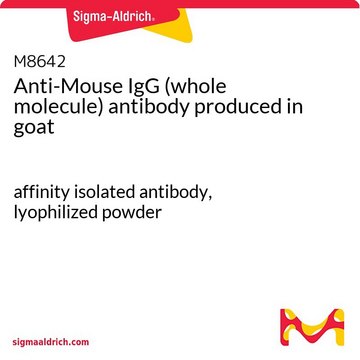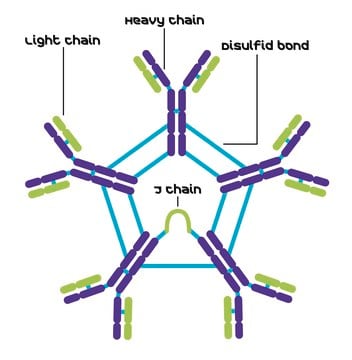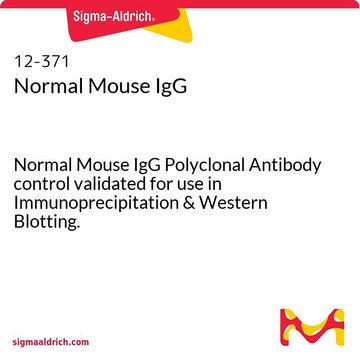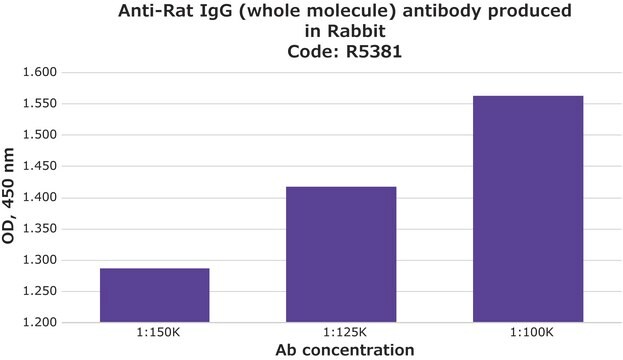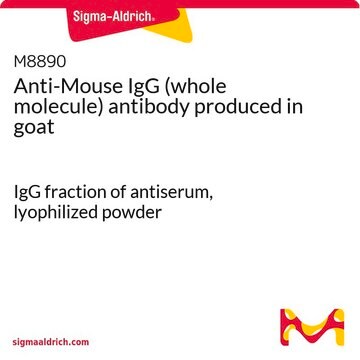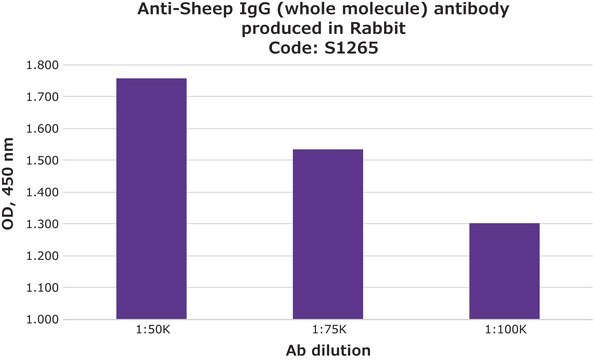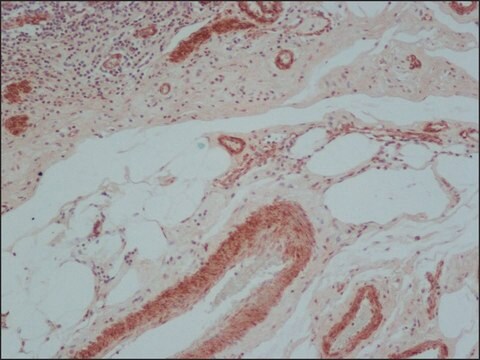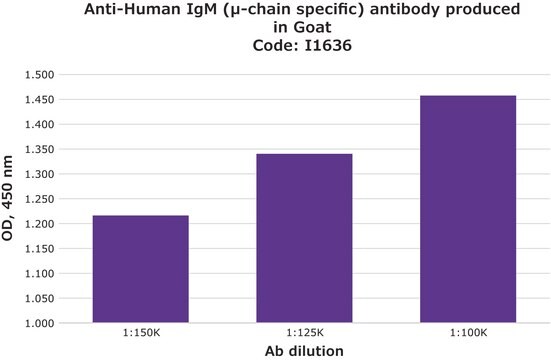M7023
Anti-Mouse IgG (whole molecule) antibody produced in rabbit
IgG fraction of antiserum, buffered aqueous solution
Sign Into View Organizational & Contract Pricing
All Photos(2)
About This Item
Recommended Products
biological source
rabbit
Quality Level
conjugate
unconjugated
antibody form
IgG fraction of antiserum
antibody product type
secondary antibodies
clone
polyclonal
form
buffered aqueous solution
technique(s)
indirect ELISA: 1:80,000
quantitative precipitin assay: 2.0 mg/mL
shipped in
dry ice
storage temp.
−20°C
target post-translational modification
unmodified
Looking for similar products? Visit Product Comparison Guide
Related Categories
General description
Immunoglobulin G (IgG) is a member of the immunoglobulin family and contains gamma (γ) heavy chain in the constant (C) region. Monomeric structure of IgG contains two identical heavy chains and two identical light chains with molecular weight of 50kDa and 25kDa respectively. The primary structure of this antibody also contains disulfide bonds implicated in linking the two heavy chains, linking the heavy and light chains and resides inside the chains. IgG is further subdivided into four classes namely, IgG1, IgG2, IgG3 and IgG4 with different heavy chains, named γ1, γ2, γ3 and γ4, respectively.
Specificity
The antiserum is determined to be immunospecific for mouse IgG by immunoelectrophoresis (IEP) versus normal mouse serum and mouse IgG. By Ouchterlony Double Diffusion (ODD) the product reacts with mouse IgG, mouse IgA and IgM.
Immunogen
Anti-Mouse IgG is produced in rabbit using purified mouse IgG as the immunogen. Whole antiserum is purified to provide an IgG fraction of antiserum.
Application
Anti-Mouse IgG (whole molecule) antibody produced in rabbit was used as secondary antibody in immunoblotting, immunoprecipitation and immunohistochemistry.
Biochem/physiol Actions
IgG antibody subtype is the most abundant of serum immunoglobulins of the immune system. It is secreted by B cells and is found in blood and extracellular fluids and provides protection from infections caused by bacteria, fungi and viruses. Maternal IgG is transferred to fetus through the placenta that is vital for immune defense of the neonate against infections.
Physical form
Solution in 0.01 M phosphate buffered saline pH 7.4, containing 15 mM sodium azide as preservative
Storage and Stability
For continuous use, store at 2-8 °C for up to one month. For extended storage, the solution may be frozen in working aliquots. Repeated freezing and thawing, or storage in "frost-free" freezers, is not recommended. If slight turbidity occurs upon prolonged storage, clarify the solution by centrifugation before use.
Disclaimer
Unless otherwise stated in our catalog or other company documentation accompanying the product(s), our products are intended for research use only and are not to be used for any other purpose, which includes but is not limited to, unauthorized commercial uses, in vitro diagnostic uses, ex vivo or in vivo therapeutic uses or any type of consumption or application to humans or animals.
Not finding the right product?
Try our Product Selector Tool.
Storage Class Code
10 - Combustible liquids
WGK
WGK 1
Flash Point(F)
Not applicable
Flash Point(C)
Not applicable
Personal Protective Equipment
dust mask type N95 (US), Eyeshields, Gloves
Choose from one of the most recent versions:
Already Own This Product?
Find documentation for the products that you have recently purchased in the Document Library.
Customers Also Viewed
A MacLaren et al.
Oncogene, 19(51), 5906-5918 (2000-12-29)
v-Jun shares the ability of the Myc, E1A, and E2F oncogenes to both sustain cell cycle progression and promote apoptosis in the absence of mitogenic stimulation. To gain an insight into the mechanism of apoptosis sensitization, we examined the possible
Lynsey Howard et al.
Stem cell research & therapy, 4(2), 36-36 (2013-04-27)
Differentiation of vascular endothelial cells (ECs) in clinically relevant numbers for injection into ischaemic areas could offer therapeutic potential in the treatment of cardiovascular conditions, including myocardial infarction, peripheral vascular disease and stroke. While we and others have demonstrated successful
M R Campanero et al.
Oncogene, 27(9), 1263-1272 (2007-08-29)
The GADD45gamma protein is a potential tumor suppressor whose expression is reduced in several tumors. However, very little is known about the regulation of its expression. We have determined that the most relevant region of its promoter lies between nucleotides
Antibody structure, instability, and formulation.
Wang W, et al.
Journal of Pharmaceutical Sciences, 96(1), 1-26 (2007)
De-Jiang Zhou et al.
Molecular medicine reports, 12(3), 4095-4102 (2015-07-02)
The present study aimed to investigate the antifibrotic effects of juglone on dimethylnitrosamine (DMN)‑induced fibrosis in rats. Juglone, which is a quinone, significantly decreased DMN‑induced rat hepatic fibrosis, which was associated with increased superoxide dismutase (SOD) activity, decreased oxidative stress
Our team of scientists has experience in all areas of research including Life Science, Material Science, Chemical Synthesis, Chromatography, Analytical and many others.
Contact Technical Service

